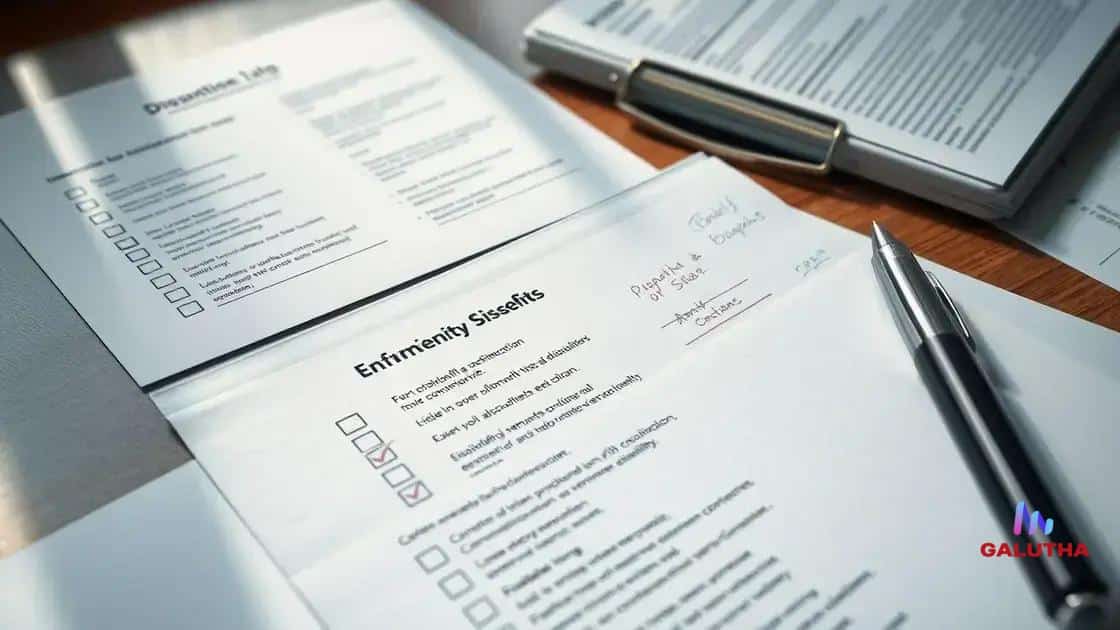Disability benefits application process explained
The disability benefits application process involves gathering necessary documents, completing the application accurately, and understanding eligibility criteria to improve your chances of approval.
The disability benefits application process can feel overwhelming at times. Ever wondered how to make it smoother? In this article, we’ll explore the critical steps to help you navigate this journey with confidence.
Understanding disability benefits
When exploring disability benefits, it’s essential to understand what these benefits entail. Many eligible individuals often find themselves asking, “What are disability benefits?” This article aims to clarify these crucial points.
What Are Disability Benefits?
Disability benefits are financial supports provided by governments or insurance programs to individuals who are unable to work due to a disability. They are designed to assist with daily living expenses and medical costs. Understanding the details can help you secure the help you need.
Types of Disability Benefits
- Social Security Disability Insurance (SSDI)
- Supplemental Security Income (SSI)
- Long-term disability insurance
- Workers’ compensation benefits
Each type of benefit serves a different purpose and eligibility may vary based on your unique situation.
Now that we have a grasp on the definitions, you might wonder how to determine your eligibility. To qualify for many programs, documentation is crucial. Medical records, employment history, and other details play an important role in the approval process. It’s important to gather all necessary documents ahead of your application.
Many applicants find themselves overwhelmed with the complexity of the application process. That’s why understanding the rules and regulations for different benefits can significantly impact your outcome. Take time to research and prepare your application carefully to maximize your chances of success.
Eligibility criteria for benefits

Understanding the eligibility criteria for benefits is crucial for anyone hoping to receive disability support. Various programs have specific requirements that applicants must meet. This section will help clarify those criteria.
Basic Criteria
To qualify for disability benefits, certain basic criteria must usually be met. These typically include being unable to work for a specific period and having a diagnosed medical condition. It’s important to document your condition and how it affects your ability to work.
Key Factors for Qualification
- Medical Evidence: Your medical records must clearly state your disability.
- Work History: You need to provide evidence of your work history, especially how it relates to your condition.
- Duration of Condition: The condition must last, or be expected to last, at least 12 months.
- Age: Age can sometimes influence eligibility for certain programs.
Having the right documentation is critical. It strengthens your application and helps prove that you meet the eligibility criteria. Many applicants tend to overlook the importance of submitting complete and accurate medical evidence.
Another vital aspect is understanding that different programs may have varying criteria. For instance, Social Security Disability Insurance (SSDI) might require a substantial work history, while Supplemental Security Income (SSI) focuses more on financial need. Knowing the details of each program will help guide your application process.
Steps to take during application
Understanding the necessary steps to take during application for disability benefits can simplify the process. Being organized and informed will help ensure that you submit a thorough and complete application.
Gather Necessary Documents
The first step you should take is to gather all required documents. This includes medical records, proof of income, and documentation of work history. Having everything in one place will reduce stress and save time when filling out your application.
Fill Out the Application Form
- Personal Information: Ensure your personal details are accurate.
- Medical Condition: Provide a thorough description of your disability.
- Work History: Include all relevant work experience and how your condition affects your ability to work.
Be as detailed as possible when completing the application form. An incomplete or vague application can delay the process or lead to denial. You want to present a strong case for your eligibility.
Submit Your Application
After carefully reviewing your application, you can submit it to the appropriate agency. Make sure to keep a copy for your records. It’s also wise to track your application so you can follow up if necessary.
During this time, stay proactive by checking in with the agency for any updates or additional requirements. They may reach out for further information, so having your documents handy can help speed up this communication.
Common challenges in the process

Navigating the application process for disability benefits can pose several challenges. Understanding these common hurdles can better prepare you for what to expect and help you approach the process with greater confidence.
Documentation Requirements
One of the biggest challenges is ensuring you have all the necessary documentation. Missing or incomplete paperwork can lead to significant delays. Common required documents include medical records, tax returns, and proof of income. Each type of benefit may have its own document requirements, making things more complex.
Long Processing Times
- Application Review: Many applicants experience long waiting periods for their applications to be processed.
- Appeals Process: If denied, the appeal process can take even longer and may require additional evidence.
- Agency Backlogs: Many disability agencies face backlogs, which can slow down overall processing times.
The lengthy processing times can be frustrating, creating financial stresses for many applicants. Patience and persistence are key during this waiting period.
Understanding Eligibility Criteria
Many applicants find it difficult to understand the eligibility criteria for various benefit programs. Each program has different requirements, and not meeting them can lead to denial. It’s important to carefully research and ensure that you fully understand these criteria before applying.
Additionally, changes to personal circumstances can affect eligibility. For instance, a change in income or medical status may impact your application and lead to confusion. Always keep updated with your status and be proactive in communicating any changes to the agency.
Tips for a successful application
Applying for disability benefits can be overwhelming, but with the right tips, you can improve your chances of a successful application. Following these guidelines will help you navigate the process more effectively.
Start Early
Begin your application process as soon as you realize you are eligible. Early preparation ensures that you have enough time to gather necessary documents and provides a cushion against any unexpected delays.
Be Thorough and Accurate
- Complete All Sections: Ensure that every part of the application is filled out completely. Incomplete applications may be denied.
- Double-Check Information: Review your information for accuracy. Even small errors can lead to complications.
- Include All Required Documents: Missing documents can slow down your application. Make a checklist to ensure everything is submitted.
Detail is crucial in your description of how your disability affects your life. Use specific examples to clearly demonstrate the limitations caused by your condition.
Consult Professionals
If possible, consider consulting a professional, such as a lawyer or an advocate, who specializes in disability benefits. They can provide valuable insights and help you understand complicated requirements. Their experienced guidance can significantly increase your chances of approval.
Lastly, keep track of all communications with the agency. Document any inquiries or additional information they request, as this will help you stay organized and efficient throughout the process.
FAQ – Frequently Asked Questions about the Disability Benefits Application Process
What is the first step in applying for disability benefits?
The first step is to gather all necessary documentation, including medical records and proof of income.
How long does the application process typically take?
The application process can vary, but it often takes several months due to reviews and potential backlogs.
What should I do if my application is denied?
If denied, you can appeal the decision. Make sure to gather additional evidence to support your case.
Can I get help with my application?
Yes, consulting professionals like lawyers or advocates who specialize in disability benefits can greatly assist you.





